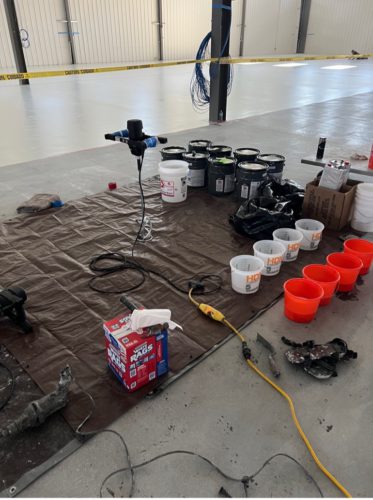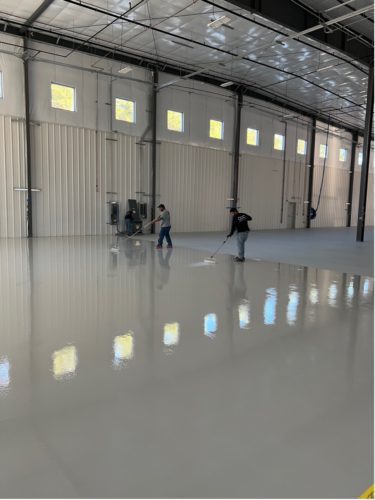Installing a water-based epoxy and urethane system in a 54,000 square feet manufacturing facility presented a number of obstacles including product availability, a tight deadline and non-climatized conditions.
I received a call in mid-October from a very reputable local construction company regarding a manufacturing facility in which they were finishing a 54,000 square foot addition. They were unhappy with the flooring contractor who had already done some work there and were looking for an alternative while also hoping to turn over the space to the client by December.
The superintendent stated the client was interested in a water-based system which would alleviate any vapor transmission through the slab given water-based coatings have some level of breathability. This system would incorporate a primer, epoxy body coat and urethane topcoat with an anti-skid additive. Given this isn’t a high-build system, we decided that diamond grinding would be best suited. It is possible that if the surface is profiled too heavily via shotblasting, some of the texture would be visible through the coatings.
Additionally, procuring this amount of product with such a short lead time was challenging. Water-based urethanes have been in short supply the past year or so. Fortunately, our vendor was able to round up materials from various locations and they delivered on-site in a timely manner.
Water-based systems have a number of advantages. As discussed, they allow for some level of breathability if there is vapor transmission through the concrete slab. Also, by not making use of solvents, water-based coatings are much better for installers’ health and the environment.
That being said, there are a few drawbacks with water-based products, one of the biggest being environmental conditions. The area we were working in did not have power and, subsequently, was not climate controlled. Water-based products are more susceptible to temperature and humidity swings than chemically cured coatings. The weather in North Carolina at this time of year can be very inconsistent. During the weeks long installation period, we experienced temperatures ranging from 35-75 F. These types of temperature fluctuations can also lead to humidity levels above 90%. We kept a temperature and humidity gauge inside the facility to constantly monitor conditions while also monitoring dew point. Finally, water-based coatings, especially urethanes, can be very tricky to install. Water-based coatings have a tendency to flash very quickly which makes them susceptible to roller marks. We were very much aware of this and made sure to install a mock-up for approval.


Installation
A 54,000 square foot area can be daunting. We knew we would have to work in sections that were large enough to meet project milestones but not so large that we were going to have roller mark and re-coat window issues (most coatings have a 24-hour recoat window).
Our first step was to complete the surface preparation, including patching. A technical representative from the coatings manufacturer was on-site to confirm the surface was profiled sufficiently in order to meet their warranty specifications.
Next, we portioned the area into roughly 15,000 square feet sections. These areas allowed sufficient time to meet re-coat sections and were wide enough we knew we could minimize roller marks.
For this size project, we had two men at the mixing station, one man putting out product, 2 men back rolling and one man (on spikes) applying a finish roll. We applied the epoxy primer the first day, the epoxy body coat the next and the urethane finish coat on the third day making sure to remain inside our 24-hour recoat window. If we were not able to meet the recoat window, we would have to abrade the surface in order for the sequential coat to adhere. Obviously, this would have created a fair amount of additional work which we wanted to avoid.
Fortunately, despite the massive temperature and humidity swings we were experiencing outside, the temperature and humidity levels stayed relatively constant inside the building.

Conclusion
Ultimately, we were able to complete the project by the December deadline and delivered a floor the client was happy with. While there were some obstacles, we completed the project within budget and consider this to be one of our most successful projects to date.